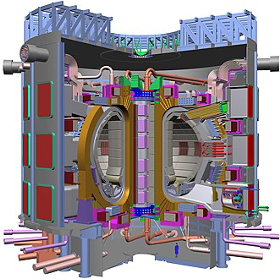Different Fusion Technologies
Our last blog mentioned a number of different fusion technologies that are progressing towards powering the first commercial fusion power plant. Here is a quick overview of these technologies:
Magnetic Confinement: This approach uses very strong magnetic fields to confine highly heated hydrogen plasma in a donut-shaped magnetic vessel (often called tokomaks). The plasma is accelerated in the vessels to energies high enough to overcome electrostatic repulsion and achieve ignition. ITER (illustration on the right) is the most successful tokomak design to date. Construction was started in 2013’ first tests are expected in 2025(when ITER is commissioned), and sustained fusion would be able to be achieved by 2035.

Inertial Confinement: Rather than using magnetic fields to compress hydrogen ions together, inertial confinement utilizes high-energy beams to create the required pressure and heat. The most successful inertial confinement machine today is the US National Ignition Facility (NIF), which uses UV lasers as the energy source. These lasers bombard a pellet of fuel 2mm in diameter, surrounded by a gold-plated covering called a hohlraum. When bombarded by the lasers, the inside of the hohlraum ablates inward, compressing and heating the deuterium-tritium (DT) fuel to the point of fusion. NIF achieved a “fusion gain break-even” ignition (where the target released more energy than was absorbed by the target) in 2013. In 2022, NIF achieved “scientific break-even” (where the target released more energy than used by the lasers) – this was the first time that scientific break-even was achieved for any type of fusion.

Pulsed Magnetic Compression: In a sense, pulsed magnetic compression (also known as magnetized linear inertial fusion or MagLIF) is a combination of magnetic confinement and inertial confinement. The primary differences between MagLIF and laser-based inertial confinement is that the laser in MagLIF is used to heat the fuel in the hohlraum of the fuel pellet rather than compress it; compression is provided by a magnetic fields that rapidly increase in intensity.
The latest example of this is the (US) Sandia National Laboratory Z-machine, which has been used to experiment with the concept and identify potential issues in the approach. The Z-machine is expected to be replaced at Sandia by the Z-pinch Inertial Fusion Energy (Z-IFE) project, which aims to provide 300MW of fusion energy in a sustainable “production” approach. Helion’s Trenta and Polaris reactors are conceptually pulsed magnetic confinement fusion machines, though it’s approach is radically different than that of the Z-machine.



